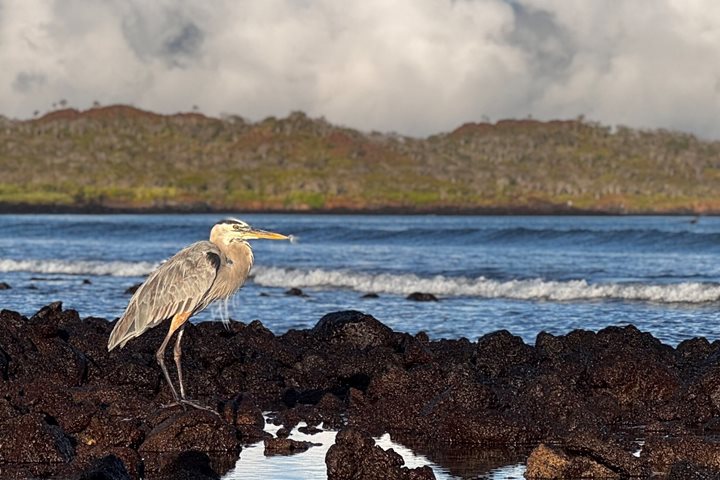Charles Darwin visited Galapagos in 1835, aboard the H.M.S Beagle, and Santiago was one of the four Islands he visited. He spent a total of five weeks in Galápagos, which included 19 days on land of which nine were spent on Santiago. Today we followed his footsteps, by visiting the same area he explored 179 years ago.
This Island was a favorite one for pirates, whalers and fur seal hunters since the islands were discovered by the Spanish in 1535. It had fresh water, a treasure in this volcanic archipelago, wood for fire and to repair the wooden vessels, and most importantly, plenty of food. This included the giant tortoises, a delicacy for many humans. Not only were thousands of these enormous reptiles killed, but they had also been taken onboard the ships, as they can survive many months without food or water. Humans were not only responsible for removing and killing those animals, but also for introducing alien species, to the point that the ecosystem of the island was completely destroyed a couple of centuries after.
In 1959, the islands were finally declared National Park, and several conservation projects started. In 1997, Lindblad Expeditions “adopted” Santiago Island and created a special fund (now the Lindblad Expeditions-National Geographic Fund for Galápagos) through which our guests could help support a major eradication effort to eliminate feral goats and pigs from the island. Today, the goats and pigs are completely gone and Lindblad Expeditions-National Geographic has been honored with a long list of prestigious awards in recognition of what was achieved on Santiago Island and elsewhere in Galápagos.
Santiago Island is a dramatic island of many colors, habitats and geological facts. It shows evidence of having had volcanic activity recently, by the long stretches of black basalt lava cliffs along the coast of James Bay. Today, before breakfast, we visited Espumilla Beach, on the western coast of Santiago Island. The beach is one of the archipelago’s most important marine turtle nesting areas and just behind the mangroves a loop trail took us inland over stony terrain, into the mature Palo Santo Forest at the top of the trail. On the way back we were delighted by a young hawk that, without showing any fear, continued to savor his meal – a male lava lizard – only a couple of feet from us.
After breakfast, we devoted the rest of the morning to exploring the waters of the historic and scenic Buccaneer Cove, a one-time pirate haunt as well as the location where Charles Darwin landed for his longest stint on land in Galápagos. Kayakers, snorkelers and glass bottom boaters were extremely happy with their choices.
Soon after lunch, guests were able to enjoy this time, the waters of Puerto Egas and James Bay. Later on, all groups gathered at the beach to start one of the most beautiful nature walks of the week. Going inland we discovered the human history of the islands, the endemic vegetation and the restoration projects, and on the way back by the shoreline, we encountered many coastal birds, marine iguanas, sea lions and even a small colony of fur seals in a dramatic setting of black lava grottos.
After a fantastic day, it was time to come back, and as we were boarding the Zodiacs the sky was giving us the last joy of the day, a beautiful sunset and red-pink skies.







